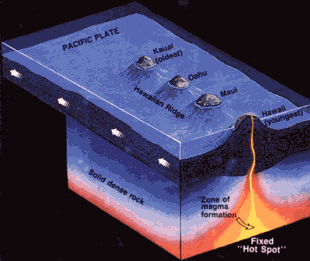[/caption]
One of the mysteries of Earth science is hotspots. While most volcanoes are found at plate boundaries, where two tectonic plates are rubbing against each other, volcanic hotspots can be anywhere, even in the middle of continents. What causes volcanic hotspots? One theory is the idea of a mantle plume.
A mantle plume is kind of like what’s going on inside a lava lamp. As the light heats up the wax in a lava lamp, it rises up through the oil in large blobs. These blobs reach the top of the lamp, cool and then sink back down to be heated up again.
Inside the Earth, the core of the Earth is very hot, and heats up the surrounding mantle. Heat convection in the mantle slowly transports heat from the core up to the Earth’s surface. These rising columns of heat can come up anywhere, and not just at the plate boundaries. Geologists did fluid dynamic experiments to try and simulate mantle plumes, and they found they formed long thin conduits topped by a bulbous head.
When the top of a mantle plume reaches the base of the Earth’s lithosphere, it flattens out and melts a large area of basalt magma. This whole region can form a continental flood basalt, which only lasts for a few million years. Or it can maintain a continuous stream of magma to a fixed location; this is a hotspot.
As the lithosphere continues to move through plate tectonics, the hotspot appears to be shifting its position over millions of years. But really the hotspot is remaining in a fixed location, and the Earth’s plates are shifting above it.
Two of the most famous places that might have mantle plumes underneath them are the Hawaiian Islands and Iceland.
We have written many articles about volcanoes and the interior of the Earth for Universe Today. Here’s an article about the difference between magma and lava, and here’s an article about magma chambers.
Here’s a great resource on mantle plumes, and here’s another.
We have recorded an entire episode of Astronomy Cast about volcanoes around the Solar System. Listen to it here: Episode 141: Volcanoes, Hot and Cold.

